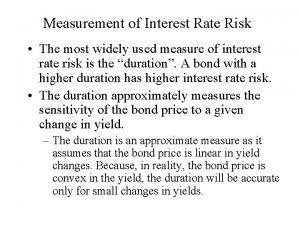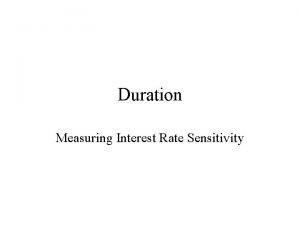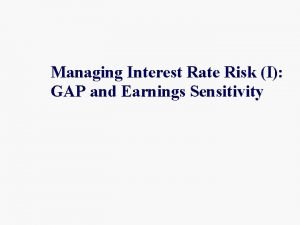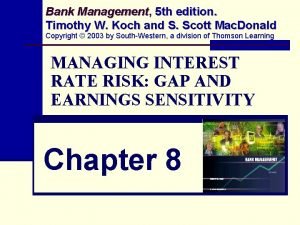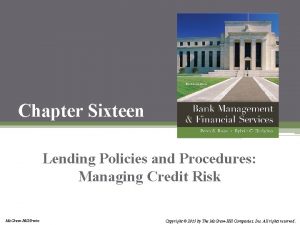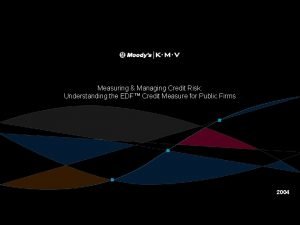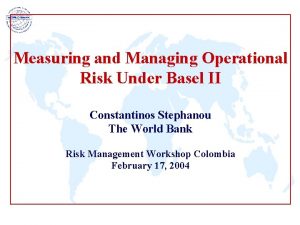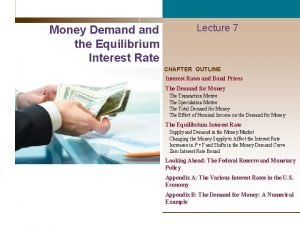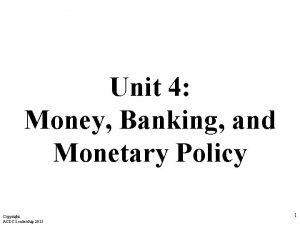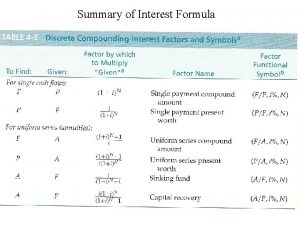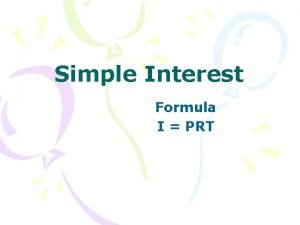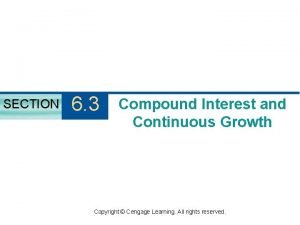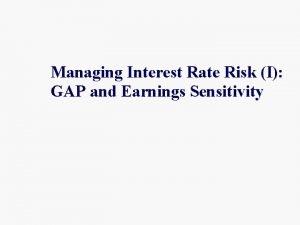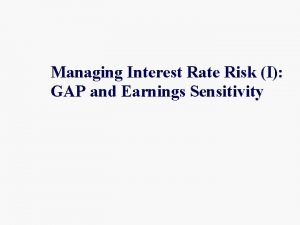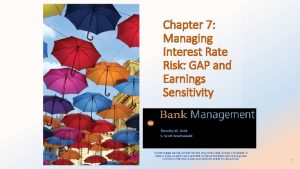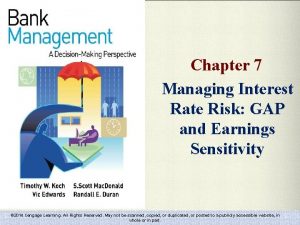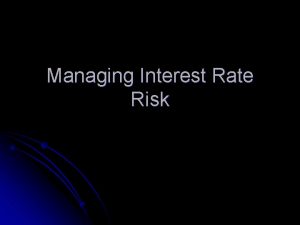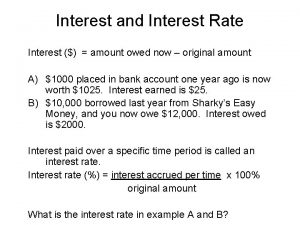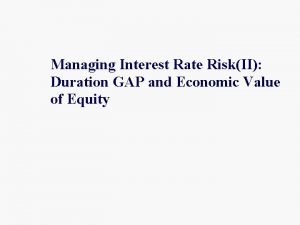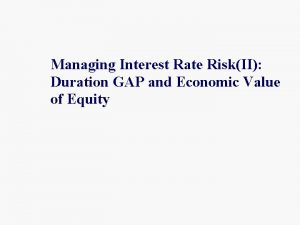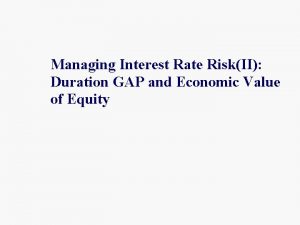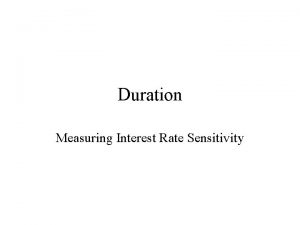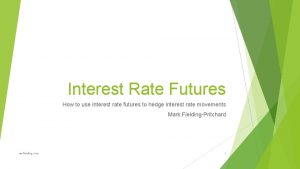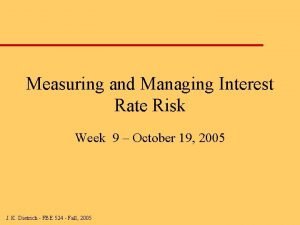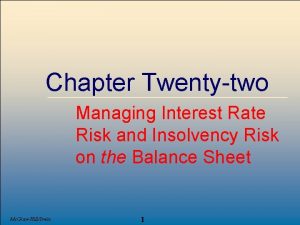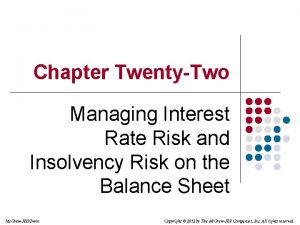Managing Interest Rate Risk I GAP and Earnings











































- Slides: 43

Managing Interest Rate Risk (I): GAP and Earnings Sensitivity

Interest Rate Risk n The potential loss from unexpected changes in interest rates which can significantly alter a bank’s profitability and market value of equity. n When a bank’s assets and liabilities do not reprice at the same time, the result is a change in net interest income. n The change in the value of assets and the change in the value of liabilities will also differ, causing a change in the value of stockholder’s equity n Banks typically focus on either: n Net interest income or n The market value of stockholders' equity The ALCO coordinates the bank’s strategies to achieve the optimal risk/reward trade-off. n GAP Analysis n n A static measure of risk that is commonly associated with net interest income (margin) targeting n Earnings Sensitivity Analysis n Earnings sensitivity analysis extends GAP analysis by focusing on changes in bank earnings due to changes in interest rates and balance sheet composition

Two Types of Interest Rate Risk n Spread Risk (reinvestment/refinancing risk) n Changes in interest rates will change the bank’s cost of funds as well as the return on their invested assets. They may change by different amounts. n Static GAP Analysis considers the impact of changing rates on the bank’s net interest income. n Price Risk n Changes in interest rates may change the market values of the bank’s assets and liabilities by different amounts. n Duration GAP considers the impact of changing rates on the market value of equity.

What Determines Rate Sensitivity (Ignoring Embedded Options)? n An asset or liability is considered rate sensitivity if during the time interval: It matures n It represents and interim, or partial, principal payment n It can be repriced n n n The interest rate applied to the outstanding principal changes contractually during the interval The outstanding principal can be repriced when some base rate of index changes and management expects the base rate / index to change during the interval

What are RSAs and RSLs? n Considering a 0 -90 day “time bucket, ” RSAs and RSLs include: n Maturing instruments or principal payments n If an asset or liability matures within 90 days, the principal amount will be repriced n Any full or partial principal payments within 90 days will be repriced n Floating and variable rate instruments n If the index will contractually change within 90 days, the asset or liability is rate sensitive n The rate may change daily if their base rate changes. § Issue: do you expect the base rate to change?

Factors Affecting Net Interest Income n Changes in the level of interest rates n Changes in the composition of assets and liabilities n Changes in the volume of earning assets and interest-bearing liabilities outstanding n Changes in the relationship between the yields on earning assets and rates paid on interest-bearing liabilities

Factors Affecting Net Interest Income: An Example n Consider the following balance sheet:

Examine the impact of the following changes n A 1% increase in the level of all short-term rates? n A 1% decrease in the spread between assets yields and interest costs such that the rate on RSAs increases to 8. 5% and the rate on RSLs increase to 5. 5%? n Changes in the relationship between shortterm asset yields and liability costs n A proportionate doubling in size of the bank?

1% increase in short-term rates With a negative GAP, more liabilities than assets reprice higher; hence NII and NIM fall

1% decrease in the spread NII and NIM fall (rise) with a decrease (increase) in the spread. Why the larger change?

Changes in the Slope of the Yield Curve n If liabilities are short-term and assets are long-term, the spread will n widen as the yield curve increases in slope n narrow when the yield curve decreases in slope and/or inverts

Proportionate doubling in size NII and GAP double, but NIM stays the same. What has happened to risk?

Changes in the Volume of Earning Assets and Interest-Bearing Liabilities n Net interest income varies directly with changes in the volume of earning assets and interest-bearing liabilities, regardless of the level of interest rates

RSAs increase to $540 while fixed-rate assets decrease to $310 and RSLs decrease to $560 while fixed-rate liabilities increase to $260 Although the bank’s GAP (and hence risk) is lower, NII is also lower.

Changes in Net Interest Income are directly proportional to the size of the GAP n If there is a parallel shift in the yield curve: n It is rare, however, when the yield curve shifts parallel n If rates do not change by the same amount and at the same time, then net interest income may change by more or less.

Summary of GAP and the Change in NII

Rate, Volume, and Mix Analysis n Banks often publish a summary of how net interest income has changed over time. n They separate changes over time to: shifts in assets and liability composition and volume n changes associated with movements in interest rates. n n The purpose is to assess what factors influence shifts in net interest income over time.

Measuring Interest Rate Risk: Synovus

Interest Rate-Sensitivity Reports Classifies a bank’s assets and liabilities into time intervals according to the minimum number of days until each instrument is expected to be repriced. n GAP values are reported a periodic and cumulative basis for each time interval. Periodic GAP n Is the Gap for each time bucket and measures the timing of potential income effects from interest rate changes n Cumulative GAP n It is the sum of periodic GAP's and measures aggregate interest rate risk over the entire period n Cumulative GAP is important since it directly measures a bank’s net interest sensitivity throughout the time interval. n

Measuring Interest Rate Risk with GAP

Advantages and Disadvantages of Static GAP Analysis n Advantages n Easy to understand n Works well with small changes in interest rates n Disadvantages n Ex-post measurement errors n Ignores the time value of money n Ignores the cumulative impact of interest rate changes n Typically considers demand deposits to be non-rate sensitive n Ignores embedded options in the bank’s assets and liabilities

Measuring Interest Rate Risk with the GAP Ratio n GAP Ratio = RSAs/RSLs n A GAP ratio greater than 1 indicates a positive GAP n A GAP ratio less than 1 indicates a negative GAP n There is no general optimal value for a bank's GAP in all environments. n Generally, the farther a bank's GAP is from zero, the greater is the bank's risk. n A bank must evaluate its overall risk and return profile and objectives to determine its optimal GAP n Neither the GAP nor GAP ratio provide direct information on the potential variability in earnings when rates change. n Consider two banks, both with $500 million in total assets. n n n Bank A: $3 mil in RSAs and $2 mil in RSLs. GAP = $1 mil and GAP ratio = 1. 5 mil Bank B: $300 mil in RSAs and $200 mil RSLs. GAP equals $100 mill and 1. 5 GAP ratio. Clearly, the second bank assumes greater interest rate risk because its net interest income will change more when interest rates change.

Link Between GAP and Net Interest Margin n Many banks will specify a target GAP to earning asset ratio in the ALCO policy statements

Establishing a Target GAP: An Example n Consider a bank with $50 million in earning assets that expects to generate a 5% NIM. n The bank will risk changes in NIM equal to plus or minus 20% during the year n Hence, NIM should fall between 4% and 6%. n If management expects interest rates to vary up to 4 percent during the upcoming year, the bank’s ratio of its 1 -year cumulative GAP (absolute value) to earning assets should not exceed 25 percent. n Target GAP/Earning assets = (. 20)(0. 05) / 0. 04 = 0. 25 n Management’s willingness to allow only a 20 percent variation in NIM sets limits on the GAP, which would be allowed to vary from $12. 5 million to $12. 5 million, based on $50 million in earning assets.

Speculating on the GAP n Many bank managers attempt to adjust the interest rate risk exposure of a bank in anticipation of changes in interest rates. n This is speculative because it assumes that management can forecast rates better than the market. n Difficult to vary the GAP and win as this requires consistently accurate interest rate forecasts n A bank has limited flexibility in adjusting its GAP; e. g. , loan and deposit terms

Earnings Sensitivity Analysis n Allows management to incorporate the impact of different spreads between asset yields and liability interest costs when rates change by different amounts.

Steps to Earnings Sensitivity Analysis n Forecast future interest rates n Identify changes in the composition of assets and liabilities in different rate environments n Forecast when embedded options will be exercised n Identify when specific assets and liabilities will reprice given the rate environment n Estimate net interest income and net income n Repeat the process to compare forecasts of net interest income and net income across different interest rate environments.

Earnings Sensitivity Analysis and the Exercise of Embedded Options § Many bank assets and liabilities contain different types of options, both explicit and implicit: n Option to refinance a loan n Call option on a federal agency bond the bank owns n Depositors have the option to withdraw funds prior to maturity n Cap (maximum) rate on a floating-rate loan

Earnings Sensitivity Analysis Recognizes that Different Interest Rates Change by Different Amounts at Different Times n It is well recognized that banks are quick to increase base loan rates but are slow to lower base loan rates when rates fall.

Recall the our example from before: n GAP 1 Yr = $0 - $10, 000 = -$10, 000 n What if rates increased? 1 year GAP Position Change in Rates -3 -2 -1, 000 -2, 000 -1 Base GAP 1 yr Change in Rates +1 +2 +3 -8, 000 -10, 000 Re-finance the auto loans All CD’s will mature

What about the 3 Month GAP Position? n Base GAP 3 m = $10, 000 - $10, 000 = 0 3 Month GAP Position Change in Rates Base Change in Rates -3 -2 -1 GAP 3 m +1 +2 +3 +8, 000 +6, 000 +2, 000 0 -1, 000 -3, 000 -6, 000 Re-finance auto loans, and less likely to “pull” CD’s People will “pull” the CD’s for higher returns

The implications of embedded options n Does the bank or the customer determine when the option is exercised? n How and by what amount is the bank being compensated for selling the option, or how much must it pay to buy the option? n When will the option be exercised? n This is often determined by the economic and interest rate environment n Static GAP analysis ignores these embedded options

Earnings Sensitivity Analysis (Base Case) Example n Assets

Earnings Sensitivity Analysis (Base Case) Example n Liabilities and GAP Measures

Interest Rate Forecasts Fed Funds Forecast vs. Implied Forward Rates 4. 50 Market Implied Rates 4. 25 %4. 00 e ta R 3. 75 s d n u F 3. 50 d e F 3. 25 3. 00 1 Most Likely. Forecast 3 5 7 9 11 13 15 17 19 21 23 Time (month) Most Likely. Forecast and Rate Ramps Dec. 2005 6 5 tn 4 e c re 3 P 2 0 11 1 3 5 7 9 12 2006 2007

Earn ings sensi tivity over one and two years vers us most likely rate scen ario

Earnings Sensitivity Analysis Results n For the bank: n The embedded options can potentially alter the bank’s cash flows n Interest rates change by different amounts at different times n Summary results are known as Earnings-at-Risk or Net Interest Income Simulation

Earnings Sensitivity Analysis n Earnings-at-Risk n The potential variation in net interest income across different interest rate environments, given different assumptions about balance sheet composition, when embedded options will be exercised, and the timing of repricings. n Demonstrates the potential volatility in earnings across these environments n The greater is the potential variation in earnings (earnings at risk), the greater is the amount of risk assumed by a bank , or n The greater is the maximum loss, the greater is risk

Income Statement GAP n Forecasts the change in net interest income given a 1% rise or fall in the bank’s benchmark rate over the next year. n It converts contractual GAP data to figures evidencing the impact of a 1% rate movement. n Income statement GAP is also know in the industry as Beta GAP analysis

Income Statement GAP Adjusts the Balance Sheet GAP to Incorporate the Earnings Change Ratio n This ratio indicates how the yield on each asset and rate paid on each liability is assumed to change relative to a 1 percent move in the benchmark rate.

Income Statement GAP

Managing the GAP and Earnings Sensitivity Risk n Steps to reduce risk n Calculate periodic GAPs over short time intervals. n Fund repriceable assets with matching repriceable liabilities so that periodic GAPs approach zero. n Fund long-term assets with matching noninterest-bearing liabilities. n Use off-balance sheet transactions to hedge.

Adjust the Effective Rate Sensitivity of a Bank’s Assets and Liabilities Objective Approaches Reduce asset sensitivity Buy longer-term securities. Lengthen the maturities of loans. Move from floating-rate loans to term loans. Increase asset sensitivity Buy short-term securities. Shorten loan maturities. Make more loans on a floating-rate basis. Reduce liability sensitivity Pay premiums to attract longer-term deposit instruments. Issue long-term subordinated debt. Increase liability sensitivity Pay premiums to attract short-term deposit instruments. Borrow more via non-core purchased liabilities.
 Nominal v. real interest rates
Nominal v. real interest rates Cap rate interest rate relationship
Cap rate interest rate relationship Measuring interest rate risk
Measuring interest rate risk Hedging interest rate risk with futures
Hedging interest rate risk with futures Interest rate sensitivity analysis
Interest rate sensitivity analysis Interest rate sensitivity analysis
Interest rate sensitivity analysis Maturity gap formula
Maturity gap formula Ncua aires questionnaire
Ncua aires questionnaire How to find the price of a bond
How to find the price of a bond Risk projection
Risk projection Credit risk market risk operational risk
Credit risk market risk operational risk Earnings at risk
Earnings at risk Simple and compound interest
Simple and compound interest Nominal.interest rate
Nominal.interest rate Interest sensitive gap management
Interest sensitive gap management Managing clinical risk
Managing clinical risk Module 4 topic 1 assessing and managing risk
Module 4 topic 1 assessing and managing risk Module 4 topic 1 assessing and managing risk
Module 4 topic 1 assessing and managing risk Identifying and managing project risk tom kendrick
Identifying and managing project risk tom kendrick Lending policies and procedures managing credit risk
Lending policies and procedures managing credit risk Managing property and liability risk
Managing property and liability risk Measuring and managing credit risk
Measuring and managing credit risk Loss event category
Loss event category Chapter 7 managing risk vision and perception
Chapter 7 managing risk vision and perception Qo'shma gap slayd
Qo'shma gap slayd Compiler bridges the semantic gap between which domains?
Compiler bridges the semantic gap between which domains? Money demand and interest rate
Money demand and interest rate What is locational arbitrage
What is locational arbitrage Money supply and interest rate
Money supply and interest rate Interest arbitrage
Interest arbitrage International arbitrage and interest rate parity
International arbitrage and interest rate parity Chapter 1 managing risk when driving
Chapter 1 managing risk when driving Process of searching critical areas in a regular sequence
Process of searching critical areas in a regular sequence Ipde steps
Ipde steps Explain what is meant by selective use of the ipde process
Explain what is meant by selective use of the ipde process Module 7 managing risk answer key
Module 7 managing risk answer key Managing clinical risk
Managing clinical risk Ground viewing driving
Ground viewing driving Chapter 4 managing risk with the ipde process
Chapter 4 managing risk with the ipde process Interest rate effect
Interest rate effect Discrete compound interest formula
Discrete compound interest formula Interest=prt
Interest=prt Interest formula math
Interest formula math How to calculate continuous compound interest
How to calculate continuous compound interest


